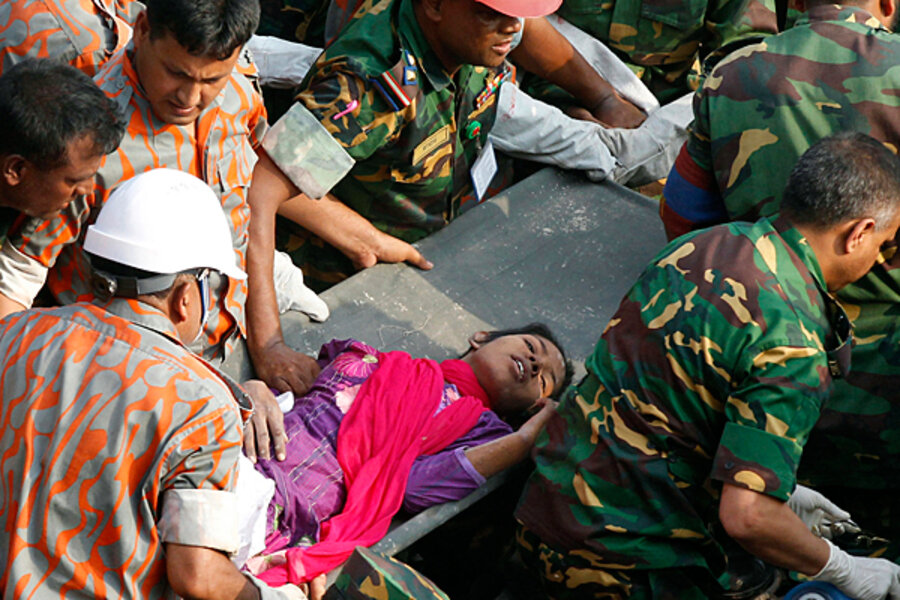Hope rises: Woman found alive 17 days after deadly Bangladesh factory collapse
Loading...
| Dhaka, Bangladesh
Seventeen days after the building collapsed killing more than 1,000 workers in Bangladesh, armed forces and firefighters have rescued one woman alive from the basement of the eight-story building at 4:28 p.m. local time, raising cautious hope that more people could still be found alive.
When the woman, whom soldiers identified as Reshma, was freed within an hour of her discovery in the flooded basement of the building, the crowd erupted in both cheers and tears. Despite her ordeal, she appeared to be in good shape and was rushed to a military hospital on the outskirts of the Bangladeshi capital.
Reshma’s rescue comes 12 days after Bangladesh mourned a failed attempt to rescue another woman, Shahina Akhter. After the death of Ms. Akhter, rescuers lost hope of finding anyone alive in the rubble and rolled out heavier equipment to clear the rubble and recover dead bodies. But with Reshma's rescue, the mood at the scene has been uplifted.
The death toll from the collapse of a building, which housed five factories, reached 1,036 today, and that number is expected to rise as more bodies are being found. The incident is being described as the world's deadliest garment industry disaster and one of the worst industrial accidents. As many as 6,000 people may have worked in the building, according to some estimates. The collapse puts a spotlight on the often extremely poor labor conditions of the country’s $20 billion garment industry, which provides cheap clothing for major retailers around the world.
As some bulldozers were crushing building beams to clear the way to look for bodies today they reached the basement, and noticed something.
“We were removing slabs. Between 2:45 p.m. and 3:00 p.m. we learned of the trace of a person,” says Lt. Col. SM Imran-Uz-Zaman, an Army spokesman at the site. “We immediately halted work in all other areas and [focused] people on rescuing Reshma.”
Maj. Gen. Chowdhury Hasan Sarwardy, coordinator of the search and rescue operations at the disaster site, told The Christian Science Monitor how she was discovered: “She shouted when we were going inside. We saw her. I talked to her,” he says.
“We have halted use of all heavy equipment such as hydraulic drilling. Our rescuers are working with information we are getting from her,” said Sarwardy – just before she was rescued.
Rescuers at the site said Reshma was confined between two beams and they had to be extremely cautious in order to rescue her alive.
After a fire broke out just before the rescue of Shahina, Imran said the rescuers put water around the perimeter of their rescue operation to ensure that wouldn’t happen again.
Once the woman was pulled out alive, says Sawardy, “we provided her with oxygen and saline.” Reshma was rescued unhurt but with complications after 17 days without food and trauma.
Though Reshma told rescuers there were no more survivors in her area, workers began to sift through nearby rubble for more survivors.
Prime Minister Sheikh Hasina congratulated the rescuers for saving Reshma. "This is an unbelievable feat," she was quoted as saying by her assistant, Mahbubul Haque Shakil.








